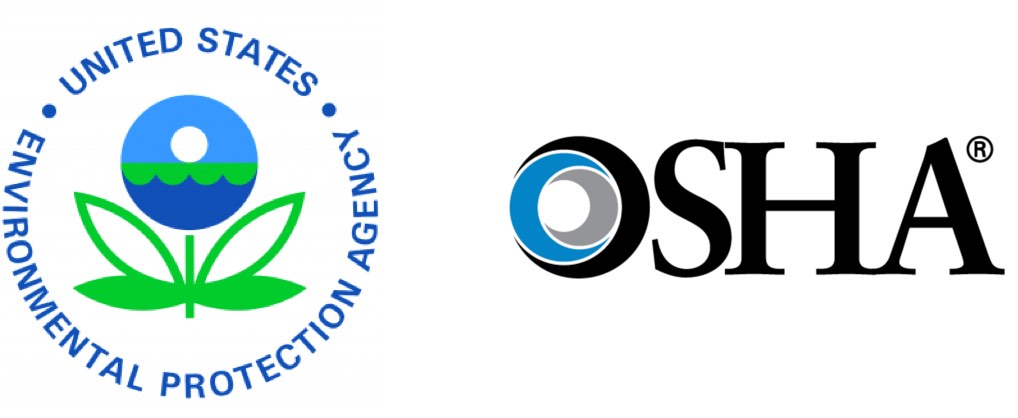Federal regulations on employee safety and environmental protection apply to businesses of all sizes, although smaller companies may be able to get their fines reduced for some violations. Setting and enforcing those regulations is the job of the Occupational Safety and Health Administration and the Environmental Protection Agency. While their jurisdictions sometimes overlap, the two agencies have distinct areas of interest.
OSHA is part of the U.S. Department of Labor and maintains a national office in Washington, D.C. The administrator of OSHA reports directly to the Secretary of Labor.
The EPA is led by its administrator, who is appointed by the president and approved by the Senate. The EPA is not a Cabinet department, but the administrator is normally given cabinet rank.
OSHA Jurisdiction
OSHA’s authority is limited to the workplace. The Occupational Safety and Health Act of 1970, the law that created the agency, requires that every employee have a workplace “free from recognized hazards that are causing or are likely to cause death or serious physical harm.” To that end, OSHA issues mandatory safety and health standards and enforces them with inspections and investigations. OSHA standards apply to all businesses that have employees, no matter how small. The only exceptions are for family farms with no non-family workers and for companies in industries with specific workplace rules set by a different federal agency, such as the Mine Safety and Health Administration.
EPA Jurisdiction
The EPA concerns itself with pollution that poses a threat to public health, with a particular focus on air and water pollution. The agency’s mission statement says its purpose is ensuring that “all Americans are protected from significant risks to human health and the environment where they live, learn and work.” Like OSHA, the EPA has issued thousands of regulations, which it enforces with inspections, investigations and, if necessary, legal action. Because of the seriousness of potential threats to human health, EPA pollution regulations generally apply to all businesses, regardless of size.
Relationship
Because of the nature of their missions, OSHA and the EPA sometimes have overlapping authority. For example, the EPA might trace a chemical spill back to a business and discover that workers there are being exposed to a hazard from the same chemical. Or an OSHA complaint about misuse of chemicals in the workplace may reveal improper disposal procedures that endanger the public. A 1991 agreement between the agencies allows for joint inspections, and it calls on one agency to alert the other when an investigation turns up evidence of violations in the other agency’s area. In other words, an OSHA investigation can quickly lead to a parallel EPA probe, and vice versa.
Small Business Resources
The EPA has a special “Small Business Compliance Policy.” To encourage small businesses to monitor themselves and report accidents and violations when they occur, the EPA allows for certain fines to be waived. If an unintentional violation didn’t cause harm, was dealt with properly, and didn’t produce an economic benefit to the company — by, for example, allowing it to save on waste-disposal costs — a small business can get many EPA fines reduced or eliminated. The EPA also gives small businesses more time to correct identified problems — 180 to 360 days, as opposed to 60 for larger businesses. OSHA, meanwhile, provides free on-site consultations to small businesses and helps them arrange hazard-reduction plans. OSHA’s penalty guidelines allow for a 10 percent to 40 percent reduction in fines for businesses with 250 or fewer employees.
State Counterparts
Business owners should be aware that both OSHA and the EPA allow states to set rules stricter than those in the federal guidelines. No state can set rules weaker than federal standards, though, and some state rules can be vetoed by the relevant federal agency. An example of the latter came in 2007, when the EPA rejected attempts by several states to set higher limits on auto pollution emissions; the EPA said that would have given automakers an impossible task of trying to comply with a patchwork of rules. About half the states have their own OSHA-like workplace safety agencies, some of which apply to all workers, others only to public employees. Every state has an environmental protection office.
Spencer-SHE has been providing Safety, Health, and Environmental Compliance Guidance since 1980, offering clients cost-effective, turn-key solutions. Our team can provide consulting services to assist in OSHA and EPA compliance issues.
Contact us here to help you to develop and maintain a safe and healthy workforce.
Sources:
https://smallbusiness.chron.com/osha-vs-epa-45018.html
https://www.usa.gov/agencies/environmental-protection-agency

